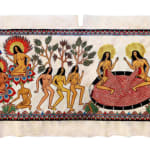Citra Sasmita
Further images
-
(View a larger image of thumbnail 1
)

-
(View a larger image of thumbnail 2
)

-
(View a larger image of thumbnail 3
)

-
(View a larger image of thumbnail 4
)

-
(View a larger image of thumbnail 5
)

-
(View a larger image of thumbnail 6
)

-
(View a larger image of thumbnail 7
)

-
(View a larger image of thumbnail 8
)

-
(View a larger image of thumbnail 9
)

-
(View a larger image of thumbnail 10
)

-
(View a larger image of thumbnail 11
)

From worldly sights, one arrives at the Anthropocene in Act One. Sasmita animates the dynamic powers of the human and superhuman as four panoramic scrolls of Kamasan paintings unfurl horizontally across Barbican’s curved walls. Kamasan paintings, the earliest form of painting in Bali, typically extend across hundreds of meters of canvas displayed along the ceiling of a traditional Balinese structure called ider-ider. A cosmological concept from Hinduism, an ider-ider refers to the notion of a central axis of energy that anchors and connects the macrocosm and microcosm of our universe. Much like planets that revolve around the sun in our solar system, human life follows cyclical patterns and philosophical narratives that provide guidelines for living and solutions to daily challenges. Sasmita thus incorporates this inclusive idea of ider-ider in Act One, reflecting on the various states of human experience: from harnessing power to releasing it; from discovery to enlightenment; suffering to salvation; sacrifice to rebirth.
Headless female figures form a ubiquitous presence, representing the relinquishing of personal ego towards greater empathy and ultimately, self-sacrifice— for the purification of one’s body and soul. Drawing parallels to the story of reincarnation in Journey to the West, the fiery figures in Sasmita’s intricate compositions undergo different stages of torture and regeneration in Fire and Water, to enter the womb of birth into a life anew. Sasmita’s own palm is also hidden within these canvases, a reminder of how deeply present the artist’s hand is in her work and a broader affirmation of her personal aspirations. She recalls drawing a map on her palm in the past, dreaming up these fantasies to visit other countries in the future, which she has since realised much of. Her own alter ego is depicted in the form of a fountain, where knowledge is growing and branching out from her head, connecting her to her ancestors and the countless heroines in Balinese history that have inspired and influenced her. Grounded in a wellspring of empowered cosmology, Sasmita sees the evolution of herself as one that has become fruitful and fertile. Such earnestness echoes throughout and to the tail end of Act One, where a lotus emerges from within, with roots stemming from the heart, and blooms at the crown chakra (the energy centre of higher thought and spiritual connection in Sanskrit). “The mind is not from the brain but the heart, that is when you receive enlightenment,” as the artist puts it.










